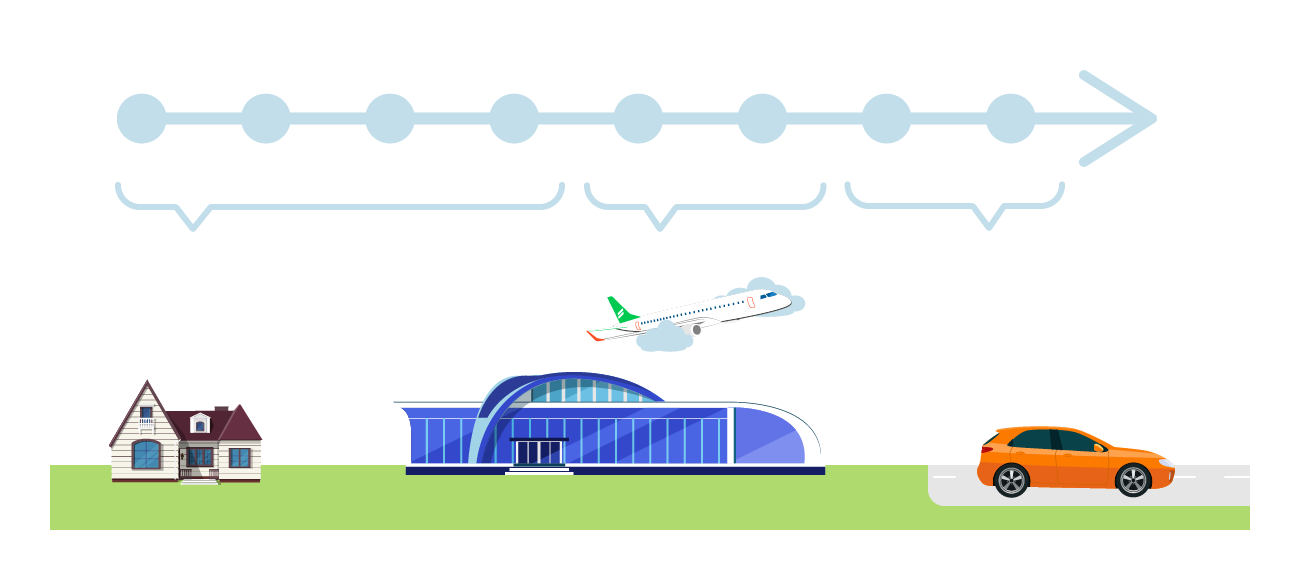In this chapter, you will see how to take on the role of an investigative journalist. To do this, you must:
Put yourself in the shoes of a typical customer and list each step.
Connect the steps into a continuous journey and gather the information together into a single overview. The overview will also include any questions or uncertainties you may have about any step or portion of the journey.
List and Order the Steps
With this customer journey map in hand, you are ready to delve into each step in detail:
A. Identify the relevant car.
B. Compare it to competing rental companies.
C. Book the preferred car.
D. Open an account on the rental company’s website.
E. Arrive at airport.
F. Take shuttle.
G. Check in and get keys at rental lot.
H. Return the car to the rental lot.
Fill in the list with information about where each action takes place::
A-D = At home
E-F = At the airport
G-H = At the rental lot

Track the Customer Each Step of the Way
Now it's time to look at how the car rental company sees the customer at each step of the journey.
Website Visit
Using a cookie to track progress over this - and future - visits, the company can deduce:
The type of car the customer is interested in renting.
Where they might want to rent it from.
Their IP address.
Their location (potentially).
Which web pages they've viewed (and for how long).
Registration
This could happen at many stages - it's up to the company to give the customer an incentive to register so they can keep in touch with them. Here they will capture all or some of:
Name
Email address
Telephone number
Location
Social media ID
Opt-in preference
Purchase
Back on the company website, the client makes the booking. Now they know:
The payment method.
Pre-reservation info (vehicle, dates, location, price).
Take Offline Steps Into Account
The rental company does not see the customer during steps E and F, which are both offline and don't directly involve the company. However, they are still important steps because they can significantly impact the customer experience. Here are two examples of how they could considerably affect the journey:
The signs pointing to the rental location are hidden from view by construction.
The shuttle is late or never arrives.
They must be included in the map because the customer is likely to blame the rental company for the inconveniences even though it is not directly responsible and has no control over airport operations.
Gather Relevant Data From Each Step
The table below sets out the types of data gathered at each of the steps to give an idea of how this will be structured in the CRM software.
Step | Location | Rental Co. Info | Personal Info | Transactional Data | Behavioral Data |
A | Home | ✅ | IP address |
| Duration |
B | Home | ❌ | / | / | / |
C | Home | ✅ | IP address | Pre-reservation info | Competing websites? |
D | Home | ✅ | First Name, Last Name, Address, Username | Payment method | Opt-in preferences |
E | Airport | ❌ | / | / | / |
F | Airport | ❌ | / | / | / |
G | Parking lot | ✅ | 2nd driver? Children? | Transaction ID |
|
H | Parking lot | ✅ |
|
| Distance |
Let's Recap!
Mapping a customer journey starts off as recreating a timeline of all the customer steps in chronological order.
Customer journey mapping requires collecting the following data: location, personal information, transactional information, and behavioral information.
Online and offline steps need to be included.
Here we are: you can now understand and detail any step of a customer journey. Next, you'll evaluate each of your customer's potential thanks to the data you collected.
